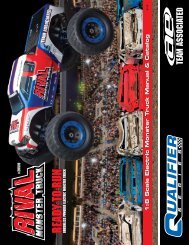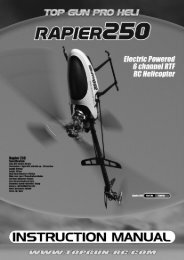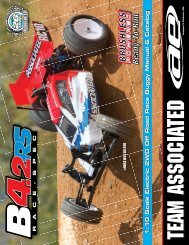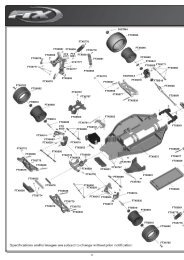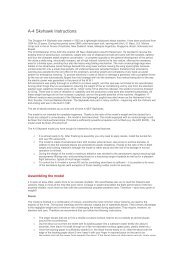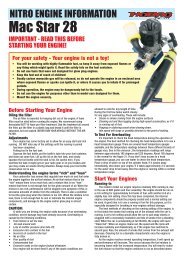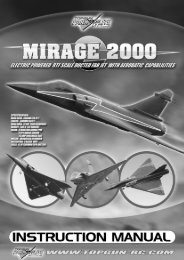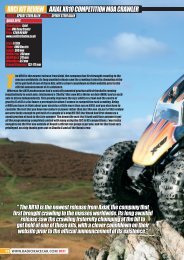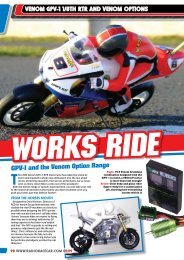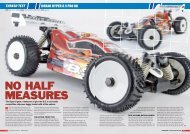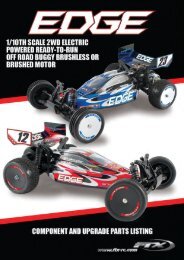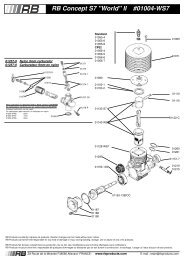Yokomo Challenger Crawler review in RRCi - CML Distribution
Yokomo Challenger Crawler review in RRCi - CML Distribution
Yokomo Challenger Crawler review in RRCi - CML Distribution
Create successful ePaper yourself
Turn your PDF publications into a flip-book with our unique Google optimized e-Paper software.
1/12th ‘<strong>Challenger</strong>’ <strong>Yokomo</strong> 1.9" Rock <strong>Crawler</strong>By Peter ‘Mad Pete’ GrayCan YouDig It?1/12th ‘<strong>Challenger</strong>’ <strong>Yokomo</strong> 1.9” Rock <strong>Crawler</strong>Rock crawl<strong>in</strong>g is the new R/Ccraze that is sett<strong>in</strong>g the<strong>in</strong>dustry alight. Easy to doanywhere and anytime it opens uplimitless possibilities and hours of funfor little expenditure. <strong>Yokomo</strong> haverecognised this and produced the 1.9”<strong>Challenger</strong>, a 1/12th scale dual motordesign that is both great value formoney and the perfect <strong>in</strong>troduction<strong>in</strong>to the world of rock crawl<strong>in</strong>gwhether you are tackl<strong>in</strong>g ruggedterra<strong>in</strong> or the liv<strong>in</strong>g room furniture!This 1.9” crawler is factory assembledbut not ready to run, though it is wellequipped with a dedicated speedcontroller capable of supply<strong>in</strong>g bothdrive motors with sufficient currentflow to climb the steepest ledge,respond<strong>in</strong>g to the helm with m<strong>in</strong>imumdelay to ultimate control to get youout of the scrape you just dared to getyourself <strong>in</strong>to.1.9" WHAT?The 1.9” diameter wheel rims set the 1/12thscale for this class, smaller than the 2.2" ofregular 1/10th scale competition. 1.9" is arelatively new crawl<strong>in</strong>g class, with their ownrules and regulations be<strong>in</strong>g developed to keepit fair for all.Inspect<strong>in</strong>g the <strong>Challenger</strong> as it rolled outof the box we found a ready pa<strong>in</strong>ted shell,trimmed and fitted to a tw<strong>in</strong> plate chassis,us<strong>in</strong>g metal ball jo<strong>in</strong>ts <strong>in</strong> plastic tie rodsas suspension l<strong>in</strong>kages to control the tw<strong>in</strong>gearboxes, which are driven completely<strong>in</strong>dividually. The rear steer<strong>in</strong>g l<strong>in</strong>kage is fixedto a rear servo mount to keep the rear wheelspo<strong>in</strong>t<strong>in</strong>g dead ahead but it looks identicalto the front system which is all set-up andjust await<strong>in</strong>g a servo <strong>in</strong>stalled on the readymounted posts and connected to the servosaver supplied. 4WS (Four Wheel Steer<strong>in</strong>g)could not be more obviously <strong>in</strong>tended, oreasier to rig up than on the 1.9" <strong>Yokomo</strong><strong>Challenger</strong>!With k<strong>in</strong>ked lower l<strong>in</strong>ks to improve clearanceover ledges and cliffs, the upper pair of l<strong>in</strong>ksare triangulated to provide axle alignment butare virtually <strong>in</strong> l<strong>in</strong>e with the lower arms withonly 8 mm offset to separate them and controlthe axles torque reaction.Wheelbase alters from 232 mm at full rideheight when there is 78 mm of clearancebelow the central skid plate, to 248 mm at fullcompression when there is still 33 mm groundclearance below the chassis. It’s not thechassis that is go<strong>in</strong>g to get hung up then, butthe gearbox lower cas<strong>in</strong>g and bumper mountshave very square bosses that protrude waybeyond the profile of the lower l<strong>in</strong>kages, sothere are bound to get hung up unless youchamfer them off. The bumper mount<strong>in</strong>gscrews sit right at the bottom of the recessedbosses so quite a lot of material can beremoved safely for an improved, chamferedlead <strong>in</strong> to rocks and other protrusions.The chassis articulation is simply amaz<strong>in</strong>g,the tw<strong>in</strong> motor set-up allows the chassis totwist until the front and rear axles are 90degrees to each other without the constra<strong>in</strong>tsof propshafts. As the motors stick so far outsideways, the gearboxes are forced to belocated offset from centre, so the primarydrive hatch cover will just touch the shockabsorber on full chassis twist and limitarticulation slightly, but under normal driv<strong>in</strong>gconditions I have yet to see the axle twist thatfar around and it shouldn’t present a problem.92 WWW.RADIORACECAR.COM 01/09
ci featureWith no central gearbox or propshafts <strong>in</strong> the way, the drivebattery can be under slung to dramatically drop the centre ofgravity, so the top deck accommodates just the lightweightelectronics like the receiver and speed controller and you can wireit all <strong>in</strong> neatly with little time and effort. I found that I could fit theelectronics to the underside of the top plate and keep the weightnice and low. The battery reta<strong>in</strong>er uses two flexible hooks to keepthe drive cells located, so you just bend one down to slide thebattery out for replacement, though most people will leave themfitted forever and just recharge as required between runs.The major effect of a tw<strong>in</strong> motor chassis is that no propshaftsmeans there is the zero torque twist <strong>in</strong>duced as the truck drivesup an <strong>in</strong>cl<strong>in</strong>e or squirms to get out of a crevice. The motors andgearboxes are <strong>in</strong> l<strong>in</strong>e with the axles, so there are no bevel boxes totry and twist the chassis sideways, you could literally run with thesoftest spr<strong>in</strong>gs fitted to the shocks and it would still crawl, all beit with a dramatically reduced ride height, like an ultimate droopset-up.TRY YOUR NEW BOOTSThe first job we did was to give the tyres the tug test, sureenough with little effort we could displace the tyres from theplastic bead lock rims, so the first th<strong>in</strong>g to do was strip each wheel,degrease the tyre beads with lighter fluid and a cotton bud, thenreassemble with a th<strong>in</strong> bead of CA adhesive run around the tyrelip. Screw<strong>in</strong>g the front plate back on as the glue starts to go offyou know straight away that the tyres are go<strong>in</strong>g to stay put, nomatter how rough the terra<strong>in</strong> gets or how tight you turn underload. There’s noth<strong>in</strong>g worse than shedd<strong>in</strong>g your boots when thego<strong>in</strong>g gets rough!The bead lock rims are a novel approach, with just three piecesand only one set of screws on the front plate as the centre portionpulls through an <strong>in</strong>ternal clamp r<strong>in</strong>g to p<strong>in</strong>ch both beads at once. Aneat idea but due to the super soft rubber compound of the tyresand the soft flexible material of the wheel rims you are ask<strong>in</strong>g toomuch if you expect the assembly to hold together under tension.CA to the rescue! Don’t worry about glu<strong>in</strong>g your new tyres to therims, as they will last so long that you may never need anotherset of tyres as long as you crawl. If you do decide to upgrade thetyres at a later date you would probably go for some of the newoptional <strong>Yokomo</strong> bead lock rims, which look like they will do thejob properly.Despite hav<strong>in</strong>g a vented tyre (the middle ‘O’ of <strong>Yokomo</strong> cleverlydrilled to let the tyre breath as well as a hole <strong>in</strong> the rim) the tyresdo not deform under the weight of the truck, which weighs <strong>in</strong> atjust 1400 g complete and ready to roll when <strong>in</strong>stalled with radiogear, a drive battery and steer<strong>in</strong>g servo! The set of four wheelsand tyres weighed only 300 g, but by add<strong>in</strong>g stick on lead weightsall around the <strong>in</strong>ner rim face we can double the weight of eachwheel, from 75 g each to 150 g exactly! From our experience <strong>in</strong>crawl<strong>in</strong>g so far I’d suggest only weight<strong>in</strong>g the front rims and allowthe lightweight rears to pull up and over a face lip once the frontsget a grip. Weight will transfer rearwards under load anyway sothe rear wheels never need so much ballast as the fronts.PUSH ME, PULL YOUA tw<strong>in</strong> motor set-up will usually ‘over speed’ the front to preventthe rear catch<strong>in</strong>g up and push<strong>in</strong>g it along, ensur<strong>in</strong>g the fronts arealways keen to be first over any obstacle and it’s up to the rearsto keep up if they can!The front motor is tagged with a red badge, while the rear hasa blue badge, so we just had to measure their revs and see if howmuch ‘overspeed’ the front gearbox would have to offer, if <strong>in</strong>deedthe rumours were correct. As the gearboxes are identical but therear faces the opposite direction to the front, the rear motor hasto rotate the opposite direction, so they are wired differentlyhence I th<strong>in</strong>k they are tagged with the colours simply for easyassembly identification.The red tagged front motor made 7680 rpm counter clockwise,while the blue tagged rear motor made 7800 rpm clockwise. So ifanyth<strong>in</strong>g the rear is over speed and push<strong>in</strong>g the front along, andbesides it’s hardly a lot of difference and noth<strong>in</strong>g I wouldn’t expectfrom standard manufactur<strong>in</strong>g variation, so I th<strong>in</strong>k we can confirmthey are <strong>in</strong>deed the same motor, just one is wired backwards.Both motors wear 13T 48DP p<strong>in</strong>ions on their 2.3 mm (3/32")diameter shafts and drive identical reduction gearboxes. Neithermotor has a flat on their shaft to offer the p<strong>in</strong>ion grub screw asecure foot<strong>in</strong>g, so I was a little paranoid that all drive could belost due to this. The motors come out easy enough for sure, sop<strong>in</strong>ion access is not at all difficult, but if I’m driv<strong>in</strong>g a long wayLeft: Tw<strong>in</strong> 370 motors rotate the opposite wayto each other, hence they need colour cod<strong>in</strong>gRight: Included <strong>Yokomo</strong> ‘SCR CL’ ESC has tw<strong>in</strong>motor output and simple one button set-upBelow: High ground clearance and no centralgearbox are key to the design01/09 WWW.RADIORACECAR.COM 93
1/12th ‘<strong>Challenger</strong>’ <strong>Yokomo</strong> 1.9" Rock <strong>Crawler</strong>to a special crawl<strong>in</strong>g venue I expect to be there to enjoymyself and not have to work on the truck dur<strong>in</strong>g the day.A stitch <strong>in</strong> time saves n<strong>in</strong>e, so it was out with the Dremeland I ground a small flat area on each motor shaft as asecure foot<strong>in</strong>g for the p<strong>in</strong>ion grub screws. It might neverslip <strong>in</strong> operation, but why take that chance.The primary drive mesh is fixed by the motor locationscrews, so remov<strong>in</strong>g a motor for <strong>in</strong>spection or clean<strong>in</strong>g isnever a worry, it goes back <strong>in</strong>to perfect mesh every time.I measured the overall drive ratio at 30:1 by just rotat<strong>in</strong>gthe wheel once and count<strong>in</strong>g the number of motorrotations <strong>in</strong> the process. That’s a crawl<strong>in</strong>g ratio, and overour usual ‘fly<strong>in</strong>g’ 20 metre top speed course with a freshlycycled 1400 mAh FTX ‘Voltz’ battery pack, the little<strong>Challenger</strong> measured a sultry 13.8 seconds, a speed of 1.4m/sec (3.2 mph).Above: The rear end is tied down butvery simple to adapt to 4WS with asecond servoLeft: The 30:1 ratio gearboxesare fully ball raced, and are keyto the overall performanceAbove: The bumper mounts and gearbox mould<strong>in</strong>gs presentobvious problems below the centre l<strong>in</strong>e…Below: …but they can soon be removed with a Dremel,for a smoother passage over obstructionsDOUBLE WIREDThe <strong>in</strong>cluded <strong>Yokomo</strong> ‘SCR-CL’ speed controller hasdouble output wires specifically for tw<strong>in</strong> motor set-upsjust like this. Fitted with a Tamiya power plug I couldn’tsee how I would connect it to the little square plug on thecells, until I spotted the adaptor lead curled up <strong>in</strong> the ESCpackag<strong>in</strong>g, they really have thought of everyth<strong>in</strong>g. Themassive heat s<strong>in</strong>k suggests it is built for heavier dutiesthan these little 370 motors, and by remov<strong>in</strong>g the heats<strong>in</strong>k I found I could <strong>in</strong>stall both the ESC and the receiverunder the top plate, either side of the battery pack fora real tidy set-up, with the centre of gravity as low aspossible.The motor leads are term<strong>in</strong>ated <strong>in</strong> regular bulletconnectors and could be plugged straight <strong>in</strong>, but for thebattery connection I prefer to chop the Tamiya and microplug right off and rather than use an adaptor lead I justsoldered myself a pair of 3.5 mm FTX gold tubes, witha male and female on the battery and correspond<strong>in</strong>ghalves on the speed controller so I could never get themplugged <strong>in</strong> backwards <strong>in</strong> a hurry.The kit <strong>Yokomo</strong> ESC is rated to 60 A cont<strong>in</strong>uous so thegold tubes are more than adequate for the job <strong>in</strong> hand,and even these tw<strong>in</strong> motors pull<strong>in</strong>g together I doubt we’llsee enough current draw to warrant the heat s<strong>in</strong>k, even ata stall on a hill, with maybe just an occasional spike whenwe jab the throttle to get out of sticky situations. Withonly a 5 V BEC regulator built <strong>in</strong> the servo speed will suffera little, but even at 5 V the Prolux high torque, all metalgeared, digital servos we have fitted for this test offer 8kg/cm of torque and a transition time of 0.27 secondsfor 60 degrees rotation. They should be plenty fastenough to correct a mistake and strong enough to holdany steer<strong>in</strong>g angle despite any sticky situation you f<strong>in</strong>dyourself <strong>in</strong>. Add<strong>in</strong>g a second servo to the rear gearboxlocation and simply extend the steer<strong>in</strong>g tie rod to reachthe servo arm and you have 4 wheel steer<strong>in</strong>g! It couldn’tbe easier! The 4WS <strong>in</strong>stallation literally halved the turn<strong>in</strong>gcircle, from 6 to just 3 feet and you could tighten thatfurther still by us<strong>in</strong>g full power as the rear literally pushedthe fronts around <strong>in</strong> an ever-tighter circle.As we <strong>in</strong>stalled the computerised radio found on theVenom GPV-1 bike, we don’t even need a ‘Y’ lead, asthe 4-channel receiver has plenty of extra sockets. TheVenom VR3T is a computerised steerwheel radio with 15model memories so I can also use it for several other usestoo, how handy is that! This three channel transmitteroffers channel mix<strong>in</strong>g so I can dial the rear steer servo<strong>in</strong>to perfection and reduce its rate a little compared tothe front so that it just assists the front steer<strong>in</strong>g actionrather than match<strong>in</strong>g it. The throttle exponential curvescome <strong>in</strong> handy too, be<strong>in</strong>g able to set a very sensitive lowspeed curve <strong>in</strong>, and yet still have max power on tap whenI need it.94 WWW.RADIORACECAR.COM 01/09
ci featureReady built and motors <strong>in</strong>stalled;just add radio and <strong>in</strong>stall thespeed controller suppliedThe only sett<strong>in</strong>g miss<strong>in</strong>g from a specific crawler speed controlleris drag brakes, but the 30:1 ratio of the ‘<strong>Challenger</strong>’ gearboxes is sohigh that the brushed motors hold the truck stationary even at some<strong>in</strong>credible angles with no throttle or brake applied at all. The ESC has noreverse lag, so you can change direction <strong>in</strong> the bl<strong>in</strong>k of an eye and catchrollovers before they get term<strong>in</strong>al. Any reverse delay would kill its rockcrawl<strong>in</strong>g potential straight off. The change of direction is so abrupt thatyou can pull short wheelies by jabb<strong>in</strong>g forwards and back repeatedly.Childish mechanical abuse for sure, but enterta<strong>in</strong><strong>in</strong>g nontheless and alltaken <strong>in</strong> its stride, prov<strong>in</strong>g a robust drivel<strong>in</strong>e and an adequately specifiedcrawler ESC.CLIMB EVERY MOUNTAINWe found the ‘<strong>Challenger</strong>’ would climb an amaz<strong>in</strong>g 60 degree <strong>in</strong>cl<strong>in</strong>e,front wheels sp<strong>in</strong>n<strong>in</strong>g away merrily as they unloaded, while the rears dug<strong>in</strong> and slowly pushed the truck forward without even a h<strong>in</strong>t of roll<strong>in</strong>g overbackwards, very stable <strong>in</strong>deed. Plac<strong>in</strong>g the truck on the <strong>in</strong>cl<strong>in</strong>ed surfacewith the throttle at neutral produced a very slow controlled roll as if ondrag brakes, reta<strong>in</strong><strong>in</strong>g grip and control all the way down.In side slip we measured an <strong>in</strong>cl<strong>in</strong>e of 64 degrees before the truck was<strong>in</strong> danger of roll<strong>in</strong>g over rather than traverse the angle properly, aga<strong>in</strong>mightily impressive for such a small truck. The kit <strong>Yokomo</strong> tyres werework<strong>in</strong>g on many surfaces despite lack<strong>in</strong>g an <strong>in</strong>sert of any k<strong>in</strong>d, and stillhardly deform<strong>in</strong>g at all.We tested the theory that the <strong>Yokomo</strong> ‘SCR-CL’ speed controller israted to handle 12 V by plugg<strong>in</strong>g <strong>in</strong> an 11.1 V 3s LiPo and to our delightit performed brilliantly, even better than we could have hoped for, evenwith the heat s<strong>in</strong>ks removed remember. The extra top speed providedjust enough ‘POP’ to get us up and over obstacles that would otherwisehave defeated us. The top speed measured 10.5 seconds for the 20metre ‘dash’, equat<strong>in</strong>g to a more usable 1.9 metres per second (4.3 mph)top speed.With no centre gearbox or propshafts, thebattery can sit real low <strong>in</strong> the middleA quick test <strong>in</strong> the street showed that go<strong>in</strong>g up and down kerb stoneswas water off a duck’s back, and not a h<strong>in</strong>t of chassis twist was evidenteven when corner<strong>in</strong>g hard on tarmac or carpet alike, the bodyshellrema<strong>in</strong><strong>in</strong>g flat and level at all times, perfect! Attack<strong>in</strong>g a 10 cmkerbstone was not such a problem so long as one tyre got to grips withthe vertical face before the bumper held the truck at bay. Such a steepclimb could be taken smoothly <strong>in</strong> typical rock crawl<strong>in</strong>g style and the rearwould follow up and over without hesitation by virtue of the rounded topedge to typical street side kerb stones.Attack<strong>in</strong>g a sharp edged 10 cm thick breeze block was a different story.Aga<strong>in</strong> you had to get one front tyre to star climb<strong>in</strong>g before the obtrusive01/09 WWW.RADIORACECAR.COM 95
1/12th ‘<strong>Challenger</strong>’ <strong>Yokomo</strong> 1.9" Rock <strong>Crawler</strong>front bumper got hung up, but once you were on the way and the frontswere over the lip, the rear would not follow because the sharp edge ofthe breeze block was catch<strong>in</strong>g on the rear lower arms. Now, you couldjust go at it on full throttle and watch the truck hop and skip about,eventually gett<strong>in</strong>g over the obstacle regardless, but <strong>in</strong> an undignifiedway, but I prefer master<strong>in</strong>g the correct technique of approach<strong>in</strong>g anymajor obstacle at a very slight angle rather than square on, so you couldtraverse even the sharp edged high climbs with style, by gett<strong>in</strong>g onefront tyre and then one rear tyre to make contact with the vertical faceand beg<strong>in</strong> lift<strong>in</strong>g that axle over clean and smooth.TO DIG OR 4WS?As much fun as four wheel steer<strong>in</strong>g is, 4WS was banned for the 2.2"class so it stands to reason it probably wouldn’t be allowed <strong>in</strong> any newrules formulated for the 1.9" trucks either. The beauty of the tw<strong>in</strong> motordesign of the <strong>Yokomo</strong> ‘<strong>Challenger</strong>’ is that an electronic ‘Dig’ unit couldeasily be rigged up to <strong>in</strong>terrupt the power to the rear axle and thenshort the motor wires together to form an electronic brake. Effectivelylock<strong>in</strong>g that axle and allow<strong>in</strong>g the front axle to carry on power<strong>in</strong>g rounda bend while the rear end holds fast, like a hand brake turn. A proper‘Dig’ unit would lock the rear prop shaft to hold the axle still and requirea separate servo, an specifically designed two piece rear propshaft witha separat<strong>in</strong>g spl<strong>in</strong>e drive and the complicated set-upthat entails. The <strong>Yokomo</strong> could be quickly convertedto an electric dig unit with noth<strong>in</strong>g more than a microswitch controlled by a t<strong>in</strong>y servo plugged <strong>in</strong>to the thirdchannel socket. Hmm there’s food for thought. We’llhave to see how the 1.9" competition rules work outand take it from there if we need to, but for now4WS is the simplest and most enjoyablesolution.ENTER THE CHALLENGERWhen the bug bites, it bites really hard, and the ma<strong>in</strong> joy of crawl<strong>in</strong>g isthe ability to do it almost anywhere and that’s what gets you hooked! It’sgood to keep a crawler ready to go <strong>in</strong> the boot of the car, so whereveryou f<strong>in</strong>d that perfect spot you can take some time out and challenge bothyourself and your rig to get to those places you never imag<strong>in</strong>ed werepossible. It’s a great way to relax and unw<strong>in</strong>d, and even get some exercisethrown <strong>in</strong> too, because wherever the crawler goes you normally have tofollow close by.This tw<strong>in</strong> motor rock crawler will <strong>in</strong>troduce you to the world of RCRock Crawl<strong>in</strong>g, and with a little modification to remove the undersideprotrusions, hav<strong>in</strong>g glued the tyres on, <strong>in</strong>stalled a 3s LiPo for a little extrapower and set-up another servo for rear wheel steer<strong>in</strong>g, we found thelittle <strong>Yokomo</strong> ‘<strong>Challenger</strong>’ was great enterta<strong>in</strong>ment, <strong>in</strong>door or outdoors, sono matter what the weather your truck triall<strong>in</strong>g fun never has to end. <strong>RRCi</strong>Below: The threepiecewheel rimsmean only one beadlock r<strong>in</strong>g is requiredFar below: Thewheel assembly wasjust too soft to stopthe tyre be<strong>in</strong>g rippedright off, so CA tyreglue was required.Note the Yok’O’movented logo to let thetyre breathAbove: With the ESC heat s<strong>in</strong>kremoved I <strong>in</strong>stalled all theelectronics below the top deck,for a lower centre of gravityBelow: Solid centre drive and ballraced axles keep all the powerflow<strong>in</strong>g to each wheel96 WWW.RADIORACECAR.COM 01/09
ci featureFar right: Fitt<strong>in</strong>g a Venom three channel computerised radiomeant we could dial it <strong>in</strong>to perfection. Prolux servos and FTXVoltz batteries completed the buildMa<strong>in</strong> pic: Even climb<strong>in</strong>g 60 degrees up a high grip surfacethere was no torque reaction, as there are no propshafts!QUICK SPECClass: 1/12th 4WD 1.9" Rock <strong>Crawler</strong>Type: Ready for Radio, <strong>in</strong>cludes ESCManufacturer: <strong>Yokomo</strong>Price: £139.99 RRPRequired to CompleteRadio: Venom VR3T <strong>in</strong>cl. 4-channel RxRadio Batteries: 8 x GP2700 NiMH AASteer<strong>in</strong>g Servo: Prolux Digital 5009FBattery: Either….7.2 V FTX Voltz 1400 mAh NiMHor 11.1 V 3-cell 1500 mAh LiPoCharger: ProluxTyre CA adhesiveDislikesBeadlock rims needed glue tooLikesFactory assembled kitFully ballraced drivel<strong>in</strong>eNo propshafts = zero torque twistEasy to convert to 4WSEasy electric ‘Dig’ conversionCONTACT<strong>CML</strong> <strong>Distribution</strong>, Tel: 01527 575349or visit www.cmldistribution.co.uk01/09 WWW.RADIORACECAR.COM 97



